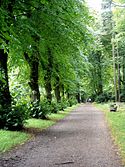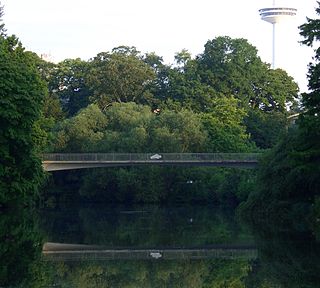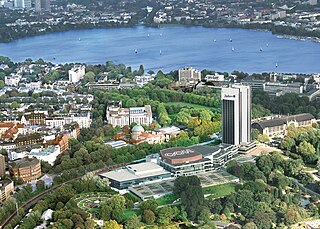Lists
Public parks
List of public urban parks in Hamburg. The list does not include protected areas such as forests or nature reserves, nor Hamburg's many park-like cemeteries.




| Name | Area [1] [2] | Est. [Note 1] | Location [Note 2] | notes |
|---|---|---|---|---|
| Alster Park [Note 3] | 169.0 ha | 1680 (1952) | several districts |  |
| Alter Elbpark | 4.2 ha | 1869 | Neustadt | |
| Altona Balkon ("Balcony") | 5.4 ha | 1638 (1952) | Altona-Altstadt | |
| Altona Volkspark | 205.0 ha | 1918 | Bahrenfeld | |
| Amsinckpark | 5.7 ha | 1868 (1956) | Lokstedt | |
| Antonipark (Park Fiction) | 0.8 ha | 2002 | St. Pauli | |
| Astronomiepark | 1912 | Bergedorf | ||
| BallinPark | 3.1 ha | 2007 | Veddel | |
| Baur's Park | 8.7 ha | 1810 (1927) | Blankenese | designed by French landscape architect Joseph-Jacques Ramée  |
| Bergedorf Rathauspark | 1.5 ha | Bergedorf | ||
| Bergedorf Schlosspark | 5.0 ha | 1805 (1896) | Bergedorf | |
| Berner Gutspark | 7.2 ha | 1880 | Farmsen-Berne | |
| Blohm's Park | 4.0 ha | 1875 (1934) | Horn | |
| Bolívarpark | 1.1 ha | Harvestehude | ||
| City-Nord-Park | 13.8 ha | 1965 | Winterhude | |
| Donner's Park | 4.3 ha | 1676 (1984) | Ottensen | |
| Domplatz | 0.5 ha | 2009 | Altstadt | |
| Eichtalpark | 8.5 ha | 1830 (1926) | Wandsbek | |
| Eimsbüttel Park | 1.9 ha | 1875 | Eimsbüttel | |
| Eppendorfer Park | 8.0 ha | 1890 | Eppendorf | |
| Gorch-Fock-Park | 2.6 ha | Finkenwerder | ||
| Große Wallanlagen | 1869 | Neustadt | ||
| Gustav-Mahler-Park | 1869 | Rotherbaum | ||
| Goßler's Park | 8.4 ha | 1795 (1924) | Blankenese | |
| Hamburg Stadtpark | 148.0 ha | 1914 | Winterhude | |
| Hammer Park | 15.9 ha | 1773 (1914) | Hamm | |
| Harburg Schlosspark | 1.5 ha | 2013 | Harburg | |
| Harburg Stadtpark | 90.0 ha | 1913 (1926) | Harburg | |
| Hans-Christian-Andersen-Park | 14.7 ha | 2009 | Osdorf | |
| Hayn's Park | 4.8 ha | 1873 (1931) | Eppendorf | |
| Heine Park | 3.4 ha | 1790 (1984) | Ottensen | |
| Henneberg Park | 3.2 ha | 1855 (1930) | Poppenbüttel | |
| Hesse Park | 3.8 ha | 1799 (1926) | Blankenese | |
| Hindenburg-Park | 1827 (1927) | Othmarschen | ||
| Hirschpark | 24.5 ha | 1620 (1927) | Blankenese | |
| Horner Park | 6.0 ha | 1909 | Horn | |
| Innocentiapark | 4.5 ha | 1884 | Harvestehude | |
| Jacobi Park | 6.0 ha | 1954 | Eilbek | |
| Jenfeld Moorpark | 5.0 ha | 2003 | Jenfeld | |
| Jenisch Park | 42.0 ha | 1785 (1927) | Othmarschen | |
| Kellinghusenpark | 2.3 ha | 1842 (1929) | Eppendorf | |
| Kleine Wallanlagen | 1869 | Neustadt | ||
| Lindenpark | 2.0 ha | 2003 | Eimsbüttel | |
| Lise-Meitner-Park | 14.3 ha | 1975 | Bahrenfeld | |
| Lohbekpark | Lokstedt | |||
| Lohsepark | 4.2 ha | 2018 | HafenCity | |
| Luna Park | Altona-Nord | |||
| Lutherpark | 8.4 ha | 2003 | Bahrenfeld | |
| Moorweide | 4.3 ha | Rotherbaum |  | |
| Neuer Elbpark Entenwerder | 16.0 ha | 1997 | Rothenburgsort | |
| Ohlendorff's Park | 1.7 ha | 1878 (1928) | Volksdorf | |
| Öjendorfer Park | 140.0 ha | 1968 | Billstedt | |
| Planten un Blomen | 47.0 ha | 1821 | Neustadt | |
| Rüschpark | 21.0 ha | 1996 | Finkenwerder | |
| Saseler Park | 2.1 ha | 1830 (1962) | Sasel | |
| Schinckel's Park | 7.0 ha | 1850 (1937) | Blankenese | |
| Schleidenpark | 1.3 ha | 1904 | Barmbek-Süd | |
| Schwarzenbergpark | 16.0 ha | 1904 | Heimfeld | |
| Seelemannpark | 0.7 ha | Eppendorf | ||
| Sternschanzenpark | 12.0 ha | 1866 | Sternschanze | |
| Sven-Simon-Park | 5.4 ha | 1952 (1980) | Blankenese | |
| Thörl's Park | 5.0 ha | Hamm | ||
| Von-Eicken-Park | 2.3 ha | 1819 (1899) | Lokstedt | |
| Wacholderpark | 1.0 ha | 1910 | Fuhlsbüttel | |
| Wehber's Park | 2.0 ha | 1852 (1926) | Eimsbüttel | |
| Wilhelmsburg Inselpark | 100.0 ha | 2013 | Wilhelmsburg |
- Legend: Alster park Elbe park Wallanlagen park
Photo impressions of Hamburg parks:
Public gardens
List of public gardens in Hamburg. In some cases, a strict distinction between park or garden may be difficult.




| name | area [1] [2] | est. [Note 1] | location [Note 2] | notes |
|---|---|---|---|---|
| Altona Dahliengarten | 1.5 ha | 1920 | Bahrenfeld | Europe's oldest dahlia garden, features ca. 850 dahlia species |
| Altona Rosengarten | 4.5 ha | 1793 (1890) | Ottensen | |
| Apothekergarten | Neustadt | |||
| Arboretum Lohbrügge | 10.0 ha | 1965 | Lohbrügge | |
| Botanical Garden (Old) | 1821 | Neustadt | ||
| Botanical Garden (New) | 24.0 ha | 1979 | Osdorf | Loki-Schmidt-Garten since 2012 |
| Botanischer Sondergarten | 5.5 ha | 1926 (1956) | Wandsbek | |
| Garten de l'Aigle | 0.8 ha | 1888 | Eppendorf | |
| Hamm Kräutergarten | 1986 | Hamm | ||
| Hamm Rosengarten | 1957 | Hamm | ||
| Harburg Schulgarten | 8.5 ha | 1931 | Harburg | |
| Japanischer Garten | 1988 | Neustadt | Europe's largest garden of its kind, designed by Japanese landscape architect Yoshikuni Araki  | |
| Planten un Blomen [Note 4] | 47.0 ha | 1821 | Neustadt | |
| Römischer Garten | 0.7 ha | 1890 (1951) | Blankenese | |
| Rosa-Luxemburg-Garten | 1926 | Eimsbüttel | ||
| Rosengarten | 0.5 ha | 1993 | Neustadt | features ca. 300 rose species |
| Volksdorf Bauerngarten | 1969 | Volksdorf | part of Volksdorf open-air museum | |
| Wilhelmsburg Rosenboulevard | 0.3 ha | 2013 | Wilhelmsburg |
- Legend: Alster park resp. garden Elbe park resp. garden Wallanlagen park resp. garden
Photo impressions of Hamburg gardens:























